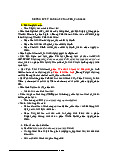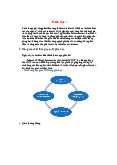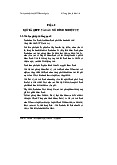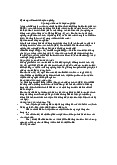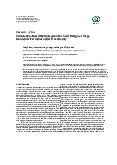





Preview text:
1) Abstract.
Thousands of important and small companies all over the world use green
marketing strategies to provide their customers finished goods that support a sustainable
environment. Group 5 will research Starbucks' use of the green market in this report. In order
to stay ahead of other competitors, the team will research how well the plan works in terms of
improving the company environment and customer performance.
2) Choose any product from the company and introduce it
Starbuck has a wide range of products from drinks to cakes and all kinds of
porcelain cups, thermos... in which water is the main product, bringing a lot of profit to the
company. Each type of drink at Starbucks has many sizes, to suit the needs of customers.
Starbucks has researched the Vietnamese market and provided criteria for selecting
ingredients for drinks (coffee type, roasting temperature, taste...)
3) Describe its target market based on demographic segmentation,
geographic segmentation, behavioral segmentation, and psychological segmentation.
Demographic segmentation is the process of dividing a target market into distinct
groups based on demographic variables such as age, gender, income, education, occupation, and more.
Age: Starbucks attracts a broad range of age groups, but it tends to have a strong
appeal to young adults and professionals. Their target demographic includes millennials
and Generation Z, who are often drawn to the brand's modern and trendy image.
Gender: Starbucks appeals to both males and females. However, it's worth noting that
the brand has made efforts to attract and cater to female customers by offering a variety
of beverages, including specialty coffees and seasonal drinks.
Income: Starbucks' products are positioned at a relatively higher price point compared
to many other coffee chains, which means it tends to attract customers with disposable
income. The brand often appeals to middle-class and upper-middle-class individuals who
are willing to spend a bit more on their coffee experience.
Education: Starbucks customers often include individuals with higher levels of
education, including college students, graduates, and professionals. The brand has
established itself as a popular meeting place for studying or casual business meetings,
attracting people who value a comfortable and stimulating environment.
Occupation: Starbucks locations can be found in various settings, including business
districts, college campuses, and residential areas. This diversity allows the brand to
attract customers from various occupations, such as office workers, students, teachers, and freelancers.
Geographic segmentation involves dividing a target market into different groups
based on geographic variables such as location, region, climate, and urban/rural areas.
Urban areas: Starbucks has a strong presence in urban areas worldwide. The brand
strategically locates its stores in city centers, business districts, and high-traffic areas to
attract customers who live or work in these urban environments. Starbucks often aims to
be a convenient stop for people on their daily commutes or during shopping trips.
Suburban areas: In addition to urban locations, Starbucks has expanded its footprint in
suburban areas as well. By opening stores in residential neighborhoods, suburban
shopping centers, and near highways, Starbucks aims to cater to customers who seek a
convenient and accessible coffee experience outside of urban settings.
International markets: Starbucks is a global brand with a widespread presence in
various countries around the world. It has expanded its operations extensively in markets
outside of the United States, including Europe, Asia, and the Middle East. The brand
adapts to the local cultures and preferences of these international markets while
maintaining its core offering and overall experience. The Starbucks menu varies by
location and offers food and drink items that are appropriate for the regional target
market, such as Sakura Blossom Latte in Japan and Maple Macchiato in Canada.
Climate considerations: While Starbucks' geographic segmentation is not solely based
on climate, the brand does take climate into account when selecting locations. For
example, in warmer climates, Starbucks may have more outdoor seating options or offer cold beverages.
Behavioral segmentation is analysis that better understands consumer behavior and customer needs.
Frequency of Consumption: Starbucks can segment customers based on the frequency
of product consumption. For example, some customers are very loyal and often visit the
store every day, while some customers only visit on special occasions.
Time of purchase: Starbucks may be interested in when customers buy and use
products. Some customers prefer to start their day with coffee in the morning, while
others prefer to visit Starbucks in the afternoon or evening.
Loyalty and Membership Program: Starbucks has a Starbucks Rewards membership
program to incentivize customer loyalty. The company can analyze customers based on
their participation and loyalty with this program.
Product selection: Starbucks segments customers based on choice and preference for
coffee and beverage products. Some customers prefer strong espresso, while others
prefer unsweetened beverages or blended iced drinks.
Use a mobile app: Starbucks has a mobile app for ordering and earning points. The
Company may analyze customers based on the use and interaction with this application.
Psychological segmentation divides people into different groups based on their
social class, lifestyle, or common behavior
Social class: Starbucks targets customers with high socioeconomic status.
The character of Starbucks will be based on the lifestyles, opinions and preferences
of customers. In addition, Starbucks customers place value in the brands they choose to be
health-conscious, socially aware, and environmentally conscious.
Non-coffee drinkers who want to socialize: Starbucks has expanded its menu to cater
to non-coffee drinkers. Selling Frappuccinos and sandwiches in the store helps attract
these customers. This allows non-coffee drinkers to join the Starbucks space and enjoy
the social atmosphere, where they can enjoy drinks and foods other than coffee.
Coffee lover: Starbucks is aimed at coffee lovers and takes their needs seriously. For
this segment, Starbucks presents top quality coffee beans from around the world. They
create diverse and high-quality coffee products to satisfy the needs of serious coffee
drinkers. This usually comes with a higher value and serves a higher income group of
customers. Because Starbucks customers are often health-conscious and interested in a
healthy lifestyle. Starbucks has developed a wide range of healthy products and drink
choices, including sugar-free beverages, plant-based milks and natural ingredients. This
allows customers to enjoy coffee and other beverages without worrying about sugar
content or unhealthy ingredients.
Starbucks has set its sights on building a brand that is socially responsible and caring
for the environment. They are committed to sustainable coffee use, community support
and supply chain equity. This attracts customers who are socially aware and interested in
issues such as equity, human rights, environmental protection and sustainable development.
4) Describe its marketing mix 4Ps and explain how the company has
executed its 4Ps implementation to follow the green marketing strategy.
Starbucks is a well-known multinational coffeehouse chain that has made efforts to
incorporate green marketing strategies into its business practices. The information below
show how Starbucks has implemented the 4Ps of marketing to align with a green marketing strategy: Product:
Starbucks has committed to sourcing ethically grown and traded coffee beans.
They work closely with farmers and invest in programs like Coffee and Farmer Equity
(C.A.F.E.) Practices to ensure fair wages, safe working conditions, and environmentally
responsible farming practices. Starbucks has made efforts to reduce its environmental
footprint by introducing recyclable and reusable packaging options. They have also set
goals to make their cups more sustainable and reduce plastic waste. For instance, when
the trend of not using plastic straws is becoming more and more popular in the US.
Starbucks, aware of this problem, changed the design of the coffee cups by using a raised
lid instead of a straw, and using wood pulp and paper to replace plastic straws. Thanks to
these improvements, Starbucks has reduced more than 1 million plastic straws each year
and contributed to protecting the environment.
Building on Starbucks sustainability commitment, the company’s goal to
expand plant-based choices as an environmentally friendly menu contributes to our goal
to be a resource positive company. Starbucks continues to introduce new drinks and food
to menus globally while innovating with plant-based ingredients across key platforms
like espresso, cold brew, refreshment, food and more. Price:
While Starbucks' pricing is not directly tied to green marketing, they have
shown a willingness to invest in sustainable sourcing practices, which can affect the cost
of their products. To maintain competition, Starbucks started with a low cost range at a
few outlets and to cater the customers who couldn’t be attracted by its high prices. The
packaged products are also available at grocery stores which are comparatively cheaper
than the normal outlet products and easily available to everyone. This proves that
Starbucks not only follows competitive pricing in its marketing mix but also relative
pricing strategies. The drinks at Starbucks are also available in various sizes as per the
need and requirement of every customer with minute variations like demi, short, mini,
tall, grande, venti and trenta. The quality is always the highest, which helps in
maintaining a loyal customer base and brand name. The price is generally high because
the focus is not only to provide high quality coffee, but it's the ambience & experience which is of high value. Place:
Starbucks has opened LEED (Leadership in Energy and Environmental
Design) certified stores in various locations worldwide. These stores are designed to be
energy-efficient, using sustainable materials and technologies to minimize their
environmental impact. Furthermore, Starbucks has also expanded its digital capabilities,
including mobile ordering and drive-thru services in many countries. This helps reduce
congestion and idling, leading to lower carbon emissions from customer transportation. Promotion:
Starbucks has launched marketing campaigns to highlight its commitment to
sustainability and green initiatives. These campaigns promote their eco-friendly
practices, such as ethical sourcing options providing benefits to farmers, coffee, tea and
cocoa sourcing areas, environment friendly techniques – using recyclable cups, green
building, etc. Besides, Starbucks has collaborated with various organizations to promote
sustainable practices and raise awareness about social and environmental issues. For
example, they have partnered with Conservation International to create the Coffee and
Farmer Equity (C.A.F.E.) Practice program.
Overall, Starbucks has implemented the 4Ps of marketing in alignment with a
green marketing strategy by offering ethically sourced products, investing in sustainable
practices, promoting eco-friendly packaging, and raising awareness about environmental
issues. These efforts reflect their commitment to being socially and environmentally conscious. 5) References.
1. Cách Starbucks trở thành người dẫn đầu khi nhắc đến Customer Loyalty | bởi AppROI
Growth Marketing Agency. (2022). Brands Vietnam.
https://www.brandsvietnam.com/congdong/topic/325969-Cach-Starbucks-tro-thanh-
nguoi-dan-dau-khi-nhac-den-Customer-Loyalty
2. Mitchell, A. (2020). Psychographic Segmentation: Advantages, Variables, & Examples.
Blog. Retrieved 2023, from https://blog.crobox.com/article/psychographic-segmentation
3. Plant-based menu innovation at Starbucks. (2020). Starbucks Stories.
https://stories.starbucks.com/stories/2020/plant-based-menu-innovation-at-starbucks/
4. Psychographic Segmentation of Starbucks - Essay - 2212 words. (n.d.). Paperdue.com.
https://www.paperdue.com/essay/psychographic-segmentation-of-starbucks-126695
5. Starbucks đang sử dụng ứng dụng di động như thế nào để tăng đáng kể doanh số ?
(2021). Your Smart Business Idea. https://smartbusiness.vn/chuyen-doi-so/digital-
business/starbucks-dang-su-dung-ung-dung-di-dong-nhu-the-nao-de-tang-dang-ke- doanh-so/
6. Starbucks Market Segmentation, Targeting, and Positioning. (n.d.). EdrawMind.
https://www.edrawmind.com/article/starbucks-market-segmentation-targeting-and- positioning.html
7. Starbucks Target Market Analysis & Marketing Strategy. (2022). Start.io.
https://www.start.io/blog/starbucks-target-market-customer-characteristics-marketing- strategy/
8. 10 Behavioral Segmentation Examples and Strategies. (2022). CleverTap.
https://clevertap.com/blog/behavioral-segmentation/
